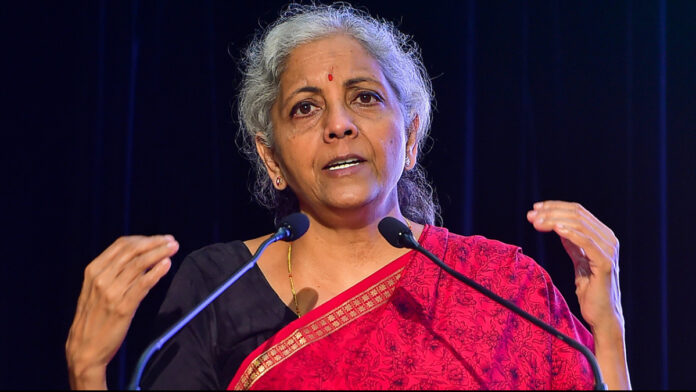In the economic history of India, several finance ministers have had the front row seat to the macro shocks that have rocked the country.From wars to the balance of payment crisis, they have seen it all, and yet, Nirmala Sitharaman’s tenure comes across as unique and arguably the toughest, even when compared to her recent predecessors who sailed through the aftermath of the 2008 financial crisis.
By Tushar Gupta
The question then beckons if Sitharaman is indeed the most consequential finance minister India has ever had.
Early Years
Her elevation, from a party spokesperson, regularly seen on primetime debates before 2014, to the Minister of Defence in 2017, raised many questions amongst political observers.
Citing her as a political lightweight, even inconsequential in the larger scheme of things, many were quick to dismiss her promotion within the government as the Minister for Commerce and Industry in 2014. Little did they know that three years later, she would be India’s Defence Minister, and in the final weeks of the government, head the critical Balakot air strike against Pakistan.
Bad Luck And Trouble
Sitharaman took over the reins from Arun Jaitley in 2019, with some big shoes to fill. Less than a year later, she presented her first complete budget, only to see the country, and the world at large, be consumed by the Covid-19 pandemic, sending all her plans for a toss.
In 2021, hopeful that the worst was behind, she presented another budget, only to see it disrupted by the Delta wave in April and the Omicron wave in December. Come 2022, and Sitharaman completed a hattrick of budget disruptions, as Putin’s war led to a complete disruption of the macro environment.
Sitharaman, as the Finance Minister, has braved it all. To have three budgets sent for a toss and still keep the economy sailing through choppy waters is no mean feat. Important to note that the economy was not in doldrums because of internal factors, but because of a once-in-a-century pandemic, and a war not many saw coming which ushered inflation unthinkable in the West and an interest rate hike spree unprecedented in recent times. Factors that were beyond the control of anyone at the helm of affairs.
Six aspects sum up Sitharaman’s unmatched competence.
Do What Is Right, Not What Looks Good
One, agile thinking during the pandemic.
Ignoring the shallow wisdom of many commentators and economists that advocated for cash drops in the early weeks of the pandemic, Sitharaman went for an agile approach. While the opposition advocated for a fiscally unsustainable cash drop to boost consumption during a phase when the country was in a lockdown, Sitharaman focussed on protecting the most vulnerable sections of the economy, starting with the direct benefit transfers and free food grains for rural population, and emergency credit for MSMEs.
The agility in the stimulus packages was mapped in last year’s Economic Survey. In March 2020, with a stimulus package of Rs 192,800 crore, close to 90 per cent focus was on food and livelihood of the poor.
The Rs 11,85,561 crore package announced between May and June 2020 was more distributed, with focus on MSMEs and agriculture where credit expansion was needed. Thus, when the country was opening up gradually, Sitharaman ensured enough liquidity for the firms dented by a lack of cash flow.
In October 2020, another Rs 73,000 crore stimulus was announced, with focus on boosting consumption and investor confidence. A month later, a stimulus package of around Rs 265,000 crore was announced, with two-third of it focussing on getting investments to India. This was the debut of the Production Linked Incentive (PLI) schemes with an outlay of around Rs 145,000 crore. While the West was struggling to get stimulus cheques delivered to the beneficiaries, Sitharaman worked with agile precision to keep the economy sailing.
Saving India’s MSMEs And Taking On China
Two, the industrial policy.
While the Narendra Modi government had always been bullish on manufacturing, the pandemic put the entire pursuit into a hyperdrive. Given the supply chain crisis, atmanirbharta became the government’s primary priority.
Across 14 sectors, the PLI schemes are expected to attract a capex of around Rs 3 lakh crore. This includes pharma, drones, electronics manufacturing, telecom and networking products, automobile components, and is expected to expand to other sectors in the future.
The electronics sector is a testament to the success of Sitharaman’s industrial policy. Electronics exports have increased three-fold since FY18, to more than $13 billion. India, today, is the second largest manufacturer of mobile phones, with an increase from 6 crore units in FY15 to over 31 crore units in FY22.
Further, an outlay of Rs 76,000 crore has also been reserved for the development of a sustainable semiconductor and display ecosystem, looking at the importance of chip atmanirbharta in the wake of the trade war between the United States and China.
Sitharaman’s industrial policy, beyond the routine headlines, also deserves credit for reducing MSMEs during the pandemic. By the end of November last year, over 1.2 crore MSME units had availed the Emergency Credit Line Guarantee Scheme, raising collateral free loans of around Rs 3.6 lakh crore.
The recovery was visible in the GST revenues, given MSMEs exceeded the pre-pandemic levels in FY22. Interestingly, the revenue buoyancy came from the micro enterprises in FY22. Even the NPA rate for these MSMEs was less than 5 per cent.
Biggest Infra Push Since Roosevelt
Three, the infrastructure spend.
In this year’s budget, Sitharaman announced an increase in the capital expenditure by 33 per cent to Rs 10 lakh crore, a four-times increase from the spend in FY16 (Rs 2.5 lakh crore). Last year, an outlay of Rs 7.5 Lakh crore was announced for infrastructure, which itself was 35 per cent more than the previous year. Stakeholders and entrepreneurs have also been hailing the government’s push for 5G services, transition towards clean energy (outlay of Rs 35,000 crore), and even housing for all under PMAY.
Both Modi and Sitharaman must be credited for India’s big infrastructure push. The National Infrastructure Pipeline, with close to 9,000 projects worth Rs 108 lakh crore has projects with a cost of around Rs 70 lakh crore under implementation.
The majority spend is in transportation, energy, social infrastructure, and water and sanitation. Projects like Dedicated Freight Corridor (DFC), critical for logistics have received a 75 per cent increase in budgetary allocation, to around Rs 27,000-odd crore from Rs 15,700 crore in the previous financial year.
Alongside, the public digital infrastructure, the national monetisation plan, and Pradhan Mantri Gati Shakti have also been critical. The digital infrastructure, starting with Aadhaar and Jan Dhan accounts, over 400 million, have been instrumental in ushering financial inclusion and credit expansion.
Going forward, with the Open Network for Digital Commerce (ONDC) becoming a reality, the impact will be seen in higher consumer demand, more localised MSMEs battling the monopoly of the likes of Amazon, etc, and so forth.
From Corporates To Common People
Four, the corporate tax reform.
Perhaps, the biggest financial reform came in the early weeks of Sitharaman’s tenure. In September 2019, Sitharaman announced that India was lowering its corporate taxes. This had four key implications. One, it made India more competitive amongst other players in their region. Two, a lower tax slab for manufacturing businesses (effective 17 per cent) aided the cause of ‘Make In India’. Three, pushed more companies to come and build in India, and four, created a business-friendly environment that would serve well post-pandemic.
Sitharaman, repeatedly, has cited how these tax cuts aided the Indian economy in hindsight. As the concerns around supply chains grew, they were instrumental in getting more companies to India. Further with more tax incentives in the PLI schemes, the government added another layer of economic appeasement for businesses.
During the UPA years, the corporate tax hovered between 33 to 38 per cent. The tax cuts, before pandemic, were also important to ensure momentum for an economy that was beginning to slow down.
Five, moving towards a lower tax regime.
To impress the ever-disappointed middle class is one herculean task, and with the new tax regime, Sitharaman seems to have accomplished that. For an income upto Rs 700,000, no income tax is to be paid.
To put things in perspective, people earning between Rs 700,001 and Rs 1,500,000 will see a significant reduction in the taxes they pay. While the government would want the new regime to boost the demand on the ground, for the beneficiaries, it is an announcement they had been waiting for since a long time.
Flexing The Fiscal Muscle
Six, commendable fiscal management.
The government is moving on from the fiscal ghosts of the pandemic year, when the deficit ballooned to 9.2 per cent of the GDP in FY21, before coming down to 6.7 per cent of the GDP in FY22, and is expected to reach 6.4 per cent in FY23. For FY24, Sitharaman’s ambitious fiscal deficit target is pegged at 5.9 per cent of the GDP. What has worked for the government is the buoyancy in revenues and the lack of populist measures including cash drops that were proposed by many.
Quite unlike her predecessor, Sitharaman is known to surround herself with more technocrats and stakeholders from the industry. This reflects in her policymaking which is responsive, agile, and allowing room for improvisation as the macroeconomic conditions evolve. Mostly, it has been about doing the right things, even if they were difficult, rather than doing things that looked good, even if they were simple. So, what will the legacy of Sitharaman’s first five years as the finance minister be about, one wonders.
That of directing the national economy through a pandemic and a war while going against the popular norm of endless stimulus and instead working to protect the vulnerable first, then sustain the industries through timely liquidity, then ensuring more push for infrastructure and investments, and finally, emerging as the lone bright spot when the entire world braces for a recession. Comparisons are inevitable, and thus, it won’t be an exaggeration to say that her legacy will outshine that of her predecessors, even from her party.
Well done, Nirmala Sitharaman.
This article first appeared in www.swarajyamag.com and it belongs to them.












